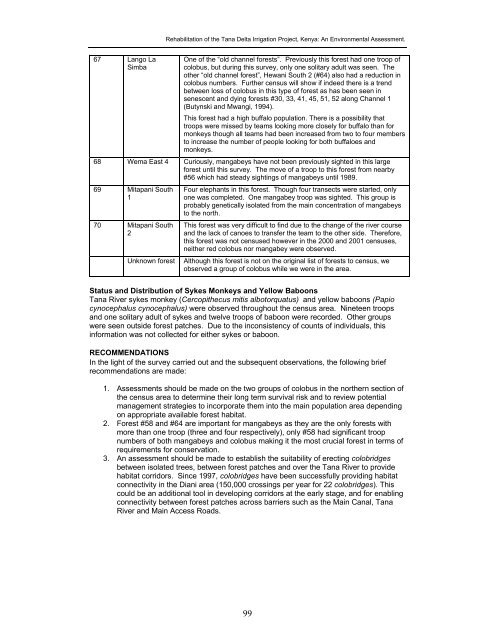Tana Delta Irrigation Project, Kenya: An Environmental Assessment
Tana Delta Irrigation Project, Kenya: An Environmental Assessment
Tana Delta Irrigation Project, Kenya: An Environmental Assessment
Create successful ePaper yourself
Turn your PDF publications into a flip-book with our unique Google optimized e-Paper software.
Rehabilitation of the <strong>Tana</strong> <strong>Delta</strong> <strong>Irrigation</strong> <strong>Project</strong>, <strong>Kenya</strong>: <strong>An</strong> <strong>Environmental</strong> <strong>Assessment</strong>.<br />
67 Lango La<br />
Simba<br />
One of the “old channel forests”. Previously this forest had one troop of<br />
colobus, but during this survey, only one solitary adult was seen. The<br />
other “old channel forest”, Hewani South 2 (#64) also had a reduction in<br />
colobus numbers. Further census will show if indeed there is a trend<br />
between loss of colobus in this type of forest as has been seen in<br />
senescent and dying forests #30, 33, 41, 45, 51, 52 along Channel 1<br />
(Butynski and Mwangi, 1994).<br />
This forest had a high buffalo population. There is a possibility that<br />
troops were missed by teams looking more closely for buffalo than for<br />
monkeys though all teams had been increased from two to four members<br />
to increase the number of people looking for both buffaloes and<br />
monkeys.<br />
68 Wema East 4 Curiously, mangabeys have not been previously sighted in this large<br />
forest until this survey. The move of a troop to this forest from nearby<br />
#56 which had steady sightings of mangabeys until 1989.<br />
69 Mitapani South<br />
1<br />
70 Mitapani South<br />
2<br />
Unknown forest<br />
Four elephants in this forest. Though four transects were started, only<br />
one was completed. One mangabey troop was sighted. This group is<br />
probably genetically isolated from the main concentration of mangabeys<br />
to the north.<br />
This forest was very difficult to find due to the change of the river course<br />
and the lack of canoes to transfer the team to the other side. Therefore,<br />
this forest was not censused however in the 2000 and 2001 censuses,<br />
neither red colobus nor mangabey were observed.<br />
Although this forest is not on the original list of forests to census, we<br />
observed a group of colobus while we were in the area.<br />
Status and Distribution of Sykes Monkeys and Yellow Baboons<br />
<strong>Tana</strong> River sykes monkey (Cercopithecus mitis albotorquatus) and yellow baboons (Papio<br />
cynocephalus cynocephalus) were observed throughout the census area. Nineteen troops<br />
and one solitary adult of sykes and twelve troops of baboon were recorded. Other groups<br />
were seen outside forest patches. Due to the inconsistency of counts of individuals, this<br />
information was not collected for either sykes or baboon.<br />
RECOMMENDATIONS<br />
In the light of the survey carried out and the subsequent observations, the following brief<br />
recommendations are made:<br />
1. <strong>Assessment</strong>s should be made on the two groups of colobus in the northern section of<br />
the census area to determine their long term survival risk and to review potential<br />
management strategies to incorporate them into the main population area depending<br />
on appropriate available forest habitat.<br />
2. Forest #58 and #64 are important for mangabeys as they are the only forests with<br />
more than one troop (three and four respectively), only #58 had significant troop<br />
numbers of both mangabeys and colobus making it the most crucial forest in terms of<br />
requirements for conservation.<br />
3. <strong>An</strong> assessment should be made to establish the suitability of erecting colobridges<br />
between isolated trees, between forest patches and over the <strong>Tana</strong> River to provide<br />
habitat corridors. Since 1997, colobridges have been successfully providing habitat<br />
connectivity in the Diani area (150,000 crossings per year for 22 colobridges). This<br />
could be an additional tool in developing corridors at the early stage, and for enabling<br />
connectivity between forest patches across barriers such as the Main Canal, <strong>Tana</strong><br />
River and Main Access Roads.<br />
99

















